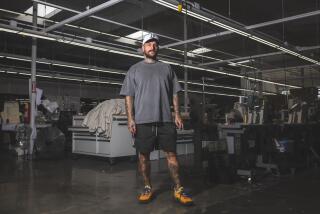Paul Van Doren, cofounder of Vans shoes, dies at 90
- Share via
Paul Van Doren, cofounder of Vans, a shoe brand that became a multi-billion-dollar action-sports empire thanks to the SoCal skate community and a focus on custom kicks, died Thursday at 90.
His death, confirmed Friday by Costa Mesa, Calif.-based Vans, comes just nine days after the publication of Van Doren’s book, “Authentic: A Memoir by the Founder of Vans.” No cause of death was given, but, according to Vans, Doren died at home surrounded by his family.
“It is with a heavy heart that Vans announces the passing of our cofounder Paul Van Doren,” the company’s statement reads in part. “Paul was not just an entrepreneur; he was an innovator. The Van Doren Rubber Co. was the culmination of a lifetime of experimentation and hard work in the shoe industry. Like Paul, from the first day of business, Vans was uniquely innovative. When the first Vans store opened, there were no stand-alone retail stores just for sneakers. Paul’s bold experiments in product design, distribution, and marketing, along with his knack for numbers, and a genius for efficiency turned Paul’s family shoe business into an all-American success story.”
Born in Massachusetts, Van Doren left school at 16 to work in a local shoe factory, a job that would set his career trajectory in motion. In 1964, his employer, Randolph Rubber Co., sent him to Southern California to help turn around a Garden Grove factory. By the following year, Van Doren and his employer had parted ways but not before a chance meeting with surf legend Duke Kahanamoku had planted the seed for a future business model.
“My dad was down in Huntington Beach,” Van Doren’s son, Steve, said in a 2016 interview with The Times. “Duke Kahanamoku was there, [surfers] Fred Hemmings, Corky Carroll and Paul Strauch were there too, and they all had these navy blue Hawaiian shirts on. ... My Dad said, ‘Duke, I can make you a pair of shoes out of that Hawaiian shirt …’ Duke gave him Fred’s shirt. My Dad went back to the Randolph factory and made a pair of shoes for him.”
To launch his shoe business, the elder Van Doren partnered with his brother, James Van Doren, and business partners Gordon Lee and Serge D’Elia. By early 1966, the wheels were in motion, and on March 16 of that year, the Van Doren Rubber Co. opened its doors at 704 E. Broadway in Anaheim. The very first style was a lace-up canvas deck shoe known as the Style 44.
The business was so new that many of the boxes on the shelves didn’t actually have shoes in them. First-day customers — between 12 and 16 in all — tried on samples and placed orders. The shoes were manufactured onsite overnight and picked up the next day.
Before hosting the official launch party for the Disney and Vans collaborative Young at Heart shoe and apparel collection that we wrote about recently, Vans’ perennially young at heart 59-year-old vice president of events and promotions, Steve Van Doren, sat down to discuss the long, intertwined relationship between the two Southern California brands.
An early embrace by the skateboarding crowd, which would often seek a single replacement shoe (the uneven wear a result of braking or sliding with a particular foot), helped buoy the young company. It eventually sponsored skateboarders including Stacy Peralta (its first sponsored skater) and Tony Alva, both of whom were instrumental in helping the company create the first dedicated skateboarding shoe in 1976.
In 1982, the company saw its fortunes change dramatically when Sean Penn wore a pair of black-and-white checkerboard slip-ons in his Jeff Spicoli surfer-stoner role in “Fast Times at Ridgemont High.” (“‘Fast Times’ definitely put us on the map,” Van Doren said in 2016. “We were about a $20-million company before the movie came out, and we were on track for $40 million to $45 million after that.”)
Van Doren, who had already retired from the company (the first time) in 1976, returned to the helm in 1984 after an ill-fated, overzealous effort to expand into other shoe categories (running, basketball, volleyball, wrestling and even break-dancing footwear) had forced it into Chapter 11 bankruptcy protection (from which it emerged in 1986).
Two years later, the cofounders sold the company to venture-banking firm McCown De Leeuw & Co. for a reported $74 million. When VF Corp. snapped up the company in 2004 in a $396-million deal, it was pulling in $325 million a year in revenue. By 2015, that had mushroomed to $2.2 billion, making the skate-fueled label VF’s most-profitable — and second-largest brand.
Van Doren Rubber Co. owed some of its success to Southern California’s burgeoning skateboard culture and gained national recognition when Sean Penn wore Vans in ‘Fast Times at Ridgemont High.’
Van Doren had been more than a quarter-century removed from the company at the time of his death. But his legacy is firmly imprinted on the VF-owned company in terms of its emphasis on skate and surf culture (Vans is the title sponsor of the U.S. Open of Surfing) and customization efforts (the label’s robust, online design-your-own-sneakers program allows you to place your own photos on pairs of its waffle-bottomed signature shoes).
It also currently employs two of his five children: son Steve, who serves as Vans’ vice president of events and promotions, and daughter Cheryl, who is vice president of human resources. (Other surviving children include Paul Jr., Taffy and Janie.)
Two grandchildren are also part of the once-family business. Kristy Van Doren serves as Vans’ senior director of marketing for the North Americas and Jenny Battiest works at the Costa Mesa-based company as merchandising manager for the Americas.
More to Read
Sign up for The Wild
We’ll help you find the best places to hike, bike and run, as well as the perfect silent spots for meditation and yoga.
You may occasionally receive promotional content from the Los Angeles Times.











